|
|
|
|
|
|
SOLD ITEMS |
|
|
|
|
|
|
|||||
|
|
|
|||||
|
|
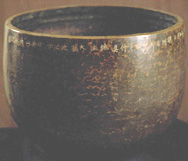 Click on image for more views |
16th Japanese Bronze Zen Buddhist Keisu Date: made in 1575 during the Momoyama Period (1568 to 1600) Material: hand-forged bronze Size: 14" diameter at rim, 16" diameter at widest area, 12" high Description: This sounding bowl or keisu, as it is refered to in Zen Buddhist tradition, is a large, spherical form, with a convex non-footed base. The surface is relatively smooth with a subtle texture which is created by the forging marks, indicating how the piece was formed. The surface has a beautiful dark bronze patina, which appears to have remained untouched for a long time, perhpas over the life of the piece. The keisu wall is about 3/16" thick. The wall gets thicker 1 1/2" from the top rim, which is about 1/2" wide all the way around. The condition is excellent. There are no cracks in the metal and the surface is completely intact. There are a few slight indentations on the bottom which are not visible when the keisu is resting on the cushion, and a tiny one on the side. These are minor and do not effect the quality of tone or aesthetics of the piece. There are 30 incised Japanese characters spanning half way around the outside of the rim located in a continuous horizontal line about 1/2" below the rim. There is a forgers mark on the top edge of the rim, midway through the row of characters. Click here for kanji translation The keisu is meant to nest into a circular cushion which rests on a wooden stand. The bowl is struck at the top edge of the rim with a specially made leather-covered wooden striking mallet to sound the instrument. It is very important that the proper mallet be used, and that the bowl rests on a cushion in order to achieve the full richness of the tone. When we acquired the piece, it was without the stand and mallet. The sound is a deep rich three-toned ring which has subtle variations and levels of intensity depending upon how hard it is struck. The bronze wall carries the vibration for several minutes, and even when the sound is no longer heard, the metal continues to vibrate to the touch. The piece is so masterfully forged and attuned to vibration, that it even responds to certain pitches of the human voice. It is said the it takes a metal craftsman ten to fifteen years to master the ability to forge such an instrument let alone achieve the proper tone. Some were forged from a flat piece of metal, some from bronze coins donated to the temple. The newer ones are either turned or cast and do not have the depth and richness of the older pieces. There are apparently very few people today who know how to do this in the way it was done over 400 years ago when this piece was made. The Keisu was used in Zen Buddhist practice in conjunction with the chanting voices of monks. It is sounded at the begining of the chanting of the sutras and for certain ceremonies such as ringing in the New Year. |
|
Item #aa01
—SOLD— |
||
|
|
|
|||||
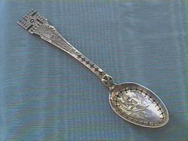 Click on image for more views |
Vintage Handmade Sterling Silver Indian Tourist Spoon This vintage sterling silver spoon, possibly made my a Navajo silversmith, produced for the Southwest tourist market in the 1940-50's. It is 5 1/2 inches long. Designs include the whirlng log motif at the top of the handle, also known to some as the swastika, but I prefer to call it by it's older name. This symbol has been used by many cultures throughout ancient history. According to Mongolian belief, it represents the Big Dipper rotating around the North Star through the seasons of the year, symbolizing the eternal cycles of life. The handle is decorated with an Indian chief in a headress, wearing buckskin leggings and holding a spear. In the bowl is another whirling log motif with a bow and two arrows. The designs have been stamped into a handcut and hammered form. Notice the hammer marks on the back of the spoon in the lower right picture. |
Item #: amin04
—SOLD— |
||||
|
|
||||||
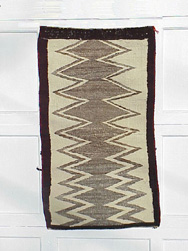 Click on image for more views |
1940's Navajo Rug This small Navajo rug is made from all handspun naturally colored sheep wool. The edging cords along the selvages are made from red wool, and the edging cords at the ends are made from tan wool. These edging cords increase the wearability of the rug and are one of the elements found on an authentic Navajo rug. Mexican imitations do not have these edging cords on the selvages or ends, and instead have a fringe on either end rather than the characteristic continuous warp loops bound by the edging cord of the real Navajo rug. The design of this rug is a striking double lightning bolt pattern. Dimensions are 24" wide by 40" long. |
Item #: amin05
—SOLD— |
||||
|
|
||||||
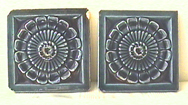 Click on image for more views |
Pair of Arts and Crafts Chelsea Ceramic Tiles This pair of tiles was made by the J & J.G. Low, Patent Art Tile Works, in Chelsea, Massachusetts, copyright 1881. All this information is imprinted on the back of the tiles. The size is 4 1/4" square. One tile is in better condition than the other, both are worn on the uppermost edges of the center design and on some of the petals. The corners of one are chipped, the other has only one corner slightly chipped. The glaze color is a lovely turquoise blue which is darker in the recessed |
Item #da02
—SOLD— |
||||
|
|
||||||
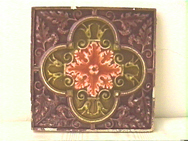 Click on image for more views |
Arts and Crafts Ceramic Tile This is a three-color tile. Although it does have some chipping along the edges, it is a very attractive tile. It is unmarked and is most likely American or possibly English. It was at one time installed in a building, probably around a fireplace, as it has some small remnants of mortar along the edges and a small chunk on the back. It is 6 inches square and 3/8 inches thick. This collection of tiles, da02, da03, da04 and da05 were all acquired in the Midwest, in Wisconsin, where there are many Arts and Crafts houses and buildings from which these tiles could have been salvaged. |
Item #da03
—SOLD— |
||||
|
|
||||||
 Click on image for more views |
Arts and Crafts Ceramic Tile This tile is glazed with two-colors and is a very lovely floral and geometric design, which is very finely detailed. In this particular tile, there is a gradation from light to dark in the design, darker where the glaze is thicker, and lighter where the glaze is thinner, adding much depth and visual interest. It is in very good condition. It has a 1 1/2 inch long pre-glaze chip along one of the edges which is covered in glaze so is not very visible. This tile is unmarked and has a series of concentric circles in relief on the back. It appears to have at one time been installed in a building and has been carefully removed without any damage to the tile. It is 6 inches square and 3/8 inches thick. This collection of tiles, da02, da03, da04 and da05 were all acquired in the Midwest, in Wisconsin, where there are many Arts and Crafts houses and buildings from which these tiles could have been salvaged. |
Item #da04
—SOLD— |
||||
|
|
||||||
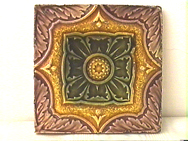 Click on image for more views |
Arts and Crafts Ceramic Tile This tile has three colors of glaze, two of which perfectly match the previous tile (da04), indicating it is made by the same company and may even have been installed in the same site. It also has some mortar remnants and the edges are a bit rough in spots along the edges. There are some wear spots on the highest relief areas of the design, the four outward-facing points in the yellow area of the design. The floral motif appears to resemble elements of a dandelion flower and leaves in the central yellow and green area. It is 6 inches square and 3/8 inches thick. This collection of tiles, da02, da03, da04 and da05 were all acquired in the Midwest, in Wisconsin, where there are many Arts and Crafts houses and buildings from which these tiles could have been salvaged. |
Item #da05
—SOLD— |
||||
|
|
||||||
|
|
||||||
|
|
||||||
|
|
|
|
|
|||
|
|
|
|
|
|||
|
|
|
|
E-MAIL US NOW: |
Golden Thread Antiques
Minneapolis, Minnesota Phone: 612.801.7552 to send an e-mail inquiry: ONLINE CONTACT FORM |